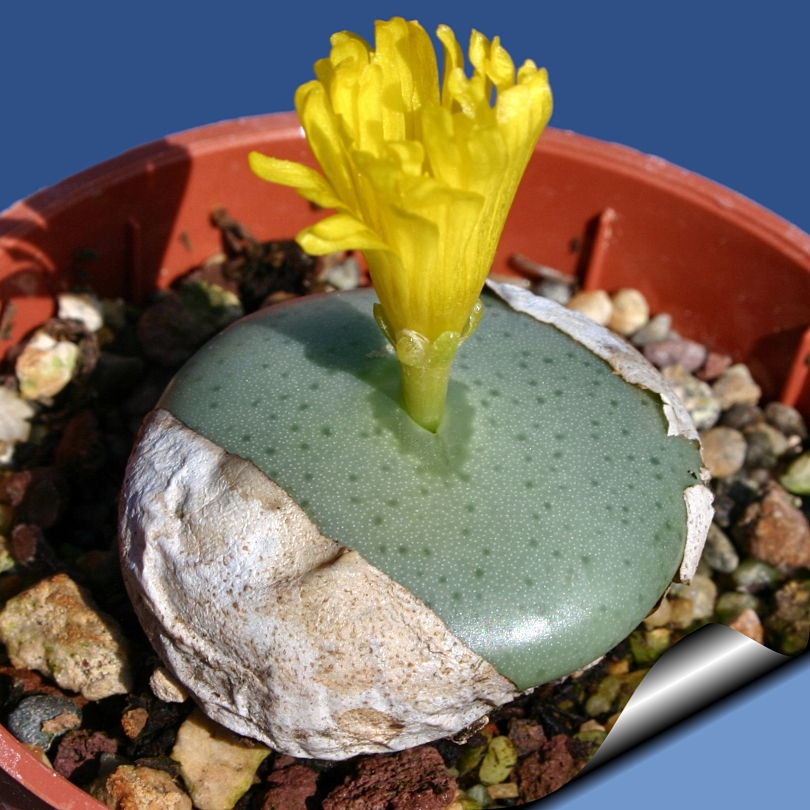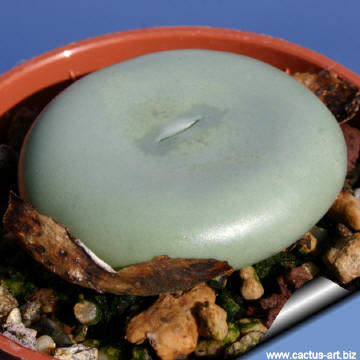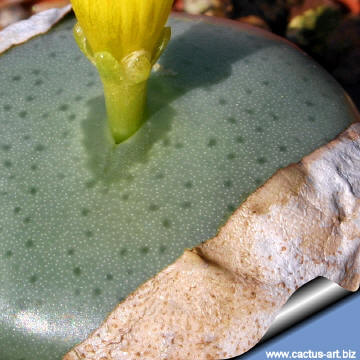|
|
|

Conophytum flavum SB2136 Kosies, Steinkopf, Little
Namaqualand, N-W Cape Province, S.A. This is a beautiful species
with quite big, flat, pale bluish-green bodies with large yellow
flowers
|

Conophytum ornatum C. flavum |

Conophytum flavum SB2136 |
|
. |
 |
 |
|
Photo of conspecific taxa, varieties, forms and
cultivars of Conophytum flavum:
|
|


Advertising
|
|
|
|
|
Family: Mesebrianthemaceae (Aizoaceae)
Scientific name: Conophytum
flavum N.E.Br. subsp. flavum (1927)
In Gardener's Chronicle & Agricultural Gazette ser. 3. lxxxi. 32. 1927
Type specimens:
Repository The Bolus Herbarium, Botany Department, University of Cape
Town, South Africa, BOL13097
Origin: Little Namaqualand, South Africa
Habitat: Grows on quartz, shale or granite outcrops, often in the crevices of the
rock .
Synonyms:
- Conophytum concinnus Schwantes 1927
- Conophytum luteopurpureum N.E.Brown (nomen nudum)
Conophytum luteum N.E.Br. 1930
- Conophytum flavum var. luteum (N.E.Br.)
Boom 1973
- Conophytum oornatum Lavis 1931
- Conophytum percrassum Schick & Tischer
1931
- Conophytum prospersum N.E.Br. Nomen
nudum
- Conophytum tetracarpum Lavis 1934
- Conophytum tictum Lavis 1934
|
|
Description: C. flavum is a tiny bluish green
succulent plant with golden yellow flowers, these plants are variably
caespitose, with single or double bodies, or forming dense mats or
cushions. This species is often difficult to distinguish from
C. wettsteinii which is indeed a different diploid species
with far smoother epidermis and violet blooms.
Body ( leaves): Large, flat, obconic, circular or elliptic in
outline viewed from above,
usually larger than 15 mm and up to 3.5 cm in diameter truncate,
slightly depressed or concave at top, surface smooth, glabrous, light
grey-green, bluish-green or whitish-green with some (usually not very
numerous) or without darker green spots scattered over the top. It has a
small growing cleft that doesn't reach right across the body.
Flowers: Large, 20-25 mm in diameter, daisy-like, yellow pale
yellowish and not scented. Petals about 55 in about 2 series, thin,
forming an almost star-like, spidery structure. Tube about long as the
entire calyx, stamens about as many as the petals, in 2-3 series, all
collected together at the mouth of the corolla tube and more or less
exserted from it; filaments yellow at the upper part; anthers of the
same yellow as the petals. Style 4 mm long nearly as long the
stamens, slender, with 4 minute stigmas at the top, yellowish at the
upper part, greenish below.
Blooming season: The
flowers open in the morning in bright sunshine, closing at the latter
part of the afternoon. Blooms mostly August trough November.
Fruit: 4-7 locular.
Smooth pale brown.
|
|
|
|

Cultivation:
C. flavum is easy to
grow. These plants grow on winter rain and head for summer dormancy.
More or less dormant in summer. The plant requires little water;
otherwise its epidermis breaks (resulting in unsightly scars). Water
throughout the year although minimally in summer, (only when the plant
starts shrivelling), but it will generally grow even in summer if given
water. Water regularly in winter after the previous year's leaves have
dried up. Requires good drainage. Keep cool and shaded from hot sun in
mid-summer; it needs full sun or light shade in the other seasons. Hardy
to -2°C. Ensure a very good ventilation. Avoid to repot frequently. This
plant may stay in the same pot for many years. Plants grown in larger
containers have frequently relatively poor flowers. It might improve
when the plants are given their own, small individual pots.
Propagation:
It can be reproduced both by cuttings and seeds. Take the cutting
from a grown-up mother plant. Each cutting
must contain one or more heads, along with
a fraction of root.
|
|